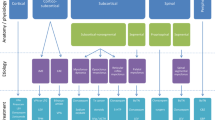Opinion statement
Myoclonus is defined as sudden, brief, shock-like involuntary movements affecting one or more muscles. The term encompasses a wide range of different physiologic and pathologic processes. When evaluating a patient with myoclonus, the first step is to identify the underlying etiology. Initial treatment should be directed against any underlying toxic or metabolic conditions. Next, targeted pharmacotherapy should be chosen, principally on the basis of the probable anatomical localization. Although treatment is initiated with a single agent, polytherapy usually is necessary to achieve adequate symptomatic control. The prognosis of myoclonus is highly variable, and largely depends on the underlying cause.
Similar content being viewed by others
References and Recommended Reading
Marsden CD, Hallett M, Fahn S: The nosology and pathophysiology of myoclonus. Mov Disord 1982:196–248.
Frucht S: Myoclonus. Curr Treat Options Neurol 2000, 2:231–241.
Caviness JN, Brown P: Myoclonus: current concepts and recent advances. Lancet Neurol 2004, 3:598–607.
Easterford K, Clough P, Kellett M, et al.: Reversible parkinsonism with normal beta-CIT-SPECT in patients exposed to sodium valproate. Neurology 2004, 62:1435–1437. This is a recent study of 50 consecutive patients treated with valproic acid. Parkinsonism occurred in three patients, and resolved in the two from whom it was subsequently with-drawn. Beta-CIT-SPECT was normal in all three patients. The findings suggest that reversible parkinsonism may be a more common side effect of valproic acid treatment than generally is recognized.
Baig SM: Acetazolamide therapy improves action myoclonus in Ramsay Hunt Syndrome. J Neurol Sci 1997, 145:123–124.
Goetting MG: Catamenial exacerbation of action myoclonus: successful treatment with acetazolamide. J Neurol Neurosurg Psychiatry 1985, 48:1304–1305.
Koskiniemi M, Van Vleymen B, Hakamies L, et al.: Piracetam relieves symptoms in progressive myoclo-nus epilepsy: a multicentre, randomised, double blind, crossover study comparing the efficacy and safety of three dosages of oral piracetam with placebo. J Neurol Neurosurg Psychiatry 1998, 64:344–348. This large, randomized, controlled trial showed the safety and efficacy of piracetam in the treatment of progressive myoclo-nus epilepsy caused by Unverricht-Lundborg disease.
Ikeda A, Shibasaki H, Tashiro K, et al.: Clinical trial of piracetam in patients with myoclonus: nationwide multiinstitution study in Japan. The Myoclonus/ Piracetam Study Group. Mov Disord 1996, 11:691–700.
Genton P, Guerrini R, Remy C: Piracetam in the treatment of cortical myoclonus. Pharmacopsychiatry 1999, 32(Suppl 1):49–53.
Lynch BA, Lambeng N, Nocka K, et al.: The synaptic vesicle protein SV2A is the binding site for the anti-epileptic drug levetiracetam. Proc Natl Acad Sci U S A 2004, 101:9861–9866.
Keswani SC, Kossoff EH, Krauss GL, Hagerty C: Amelioration of spinal myoclonus with levetiracetam. J Neurol Neurosurg Psychiatry 2002, 73:457–458. The authors reported on three patients with spinal myoclonus of varying etiologies who improved with levetiracetam treatment.
Krauss GL, Bergin A, Kramer RE, et al.: Suppression of post-hypoxic and post-encephalitic myoclonus with levetiracetam. Neurology 2001, 56:411–412. This is a report of three patients with post-hypoxic or post-encephalitic action myoclonus who responded to treatment with levetiracetam.
Frucht SJ, Louis ED, Chuang C, Fahn S: A pilot tolerability and efficacy study of levetiracetam in patients with chronic myoclonus. Neurology 2001, 57:1112–1114. This is an open-label trial in which three of five patients with cortical myoclonus had a symptomatic improvement (and no significant side effects) with levetiracetam treatment.
Magaudda A, Gelisse P, Genton P: Antimyoclonic effect of levetiracetam in 13 patients with Unverricht-Lundborg disease: clinical observations. Epilepsia 2004, 45:678–681.
Leppik IE: Zonisamide. Epilepsia 1999, 40(Suppl 5):S23-S29.
Wallace SJ: Newer antiepileptic drugs: advantages and disadvantages. Brain Dev 2001, 23:277–283.
Kyllerman M, Ben-Menachem E: Zonisamide for pro-gressive myoclonus epilepsy: long-term observations in seven patients. Epilepsy Res 1998, 29:109–114. This is a report of seven patients with progressive myoclonus epilepsy (due to Unverricht-Lundborg or Lafora Body disease) that responded to adjunctive therapy with zonisamide.
Siniscalchi A, Mancuso F, Russo E, et al.: Spinal myoclonus responsive to topiramate. Mov Disord 2004, 19:1380–1381. This is a case report of a patient with spinal segmental myoclonus (in an amputation stump) who responded to treatment with topiramate.
Priori A, Bertolasi L, Pesenti A, et al.: Gamma-hydroxy-butyric acid for alcohol-sensitive myoclonus with dystonia. Neurology 2000, 54:1706.
Defazio G, Abbruzzese G, Girlanda P, et al.: Botulinum toxin A treatment for primary hemifacial spasm: a 10-year multicenter study. Arch Neurol 2002, 59:418–420. This multicenter, retrospective case review reported on 65 patients, showing the safety and efficacy of botulinum toxin A in the treatment of hemifacial spasm.
Liu X, Griffin IC, Parkin SG, et al.: Involvement of the medial pallidum in focal myoclonic dystonia: A clinical and neurophysiological case study. Mov Disord 2002, 17:346–353.
Kupsch A, Trottenberg T, Meissner W, Funk T: Neuro-stimulation of the ventral intermediate thalamic nucleus alleviates hereditary essential myoclonus. J Neurol Neurosurg Psychiatry 1999, 67:415–416.
Trottenberg T, Meissner W, Kabus C, et al.: Neurostimu-lation of the ventral intermediate thalamic nucleus in inherited myoclonus-dystonia syndrome. Mov Disord 2001, 16:769–771.
Author information
Authors and Affiliations
Rights and permissions
About this article
Cite this article
Nirenberg, M.J., Frucht, S.J. Myoclonus. Curr Treat Options Neurol 7, 221–230 (2005). https://doi.org/10.1007/s11940-005-0015-1
Issue Date:
DOI: https://doi.org/10.1007/s11940-005-0015-1




